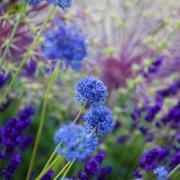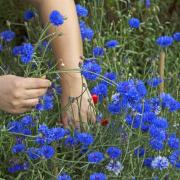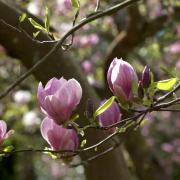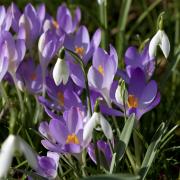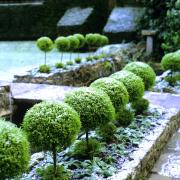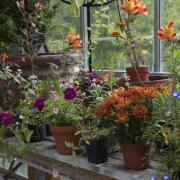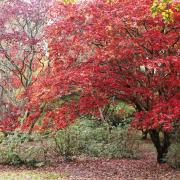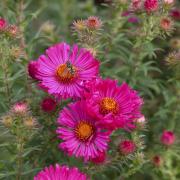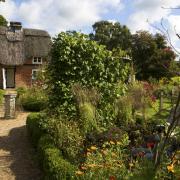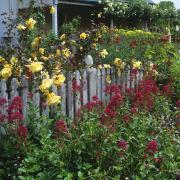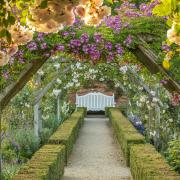With our spending extra time in the garden during the COVID-19 pandemic we’ve had the opportunity to really assess each area of our own backyards. It’s unknown at the time of writing whether we will be able to resume garden visiting, however here is some inspiration for creating charming little vignettes in your own garden to enjoy from both outside and inside.

Seaside seating
Keen gardeners Angela and Peter Arnold regularly improve and change the various areas within their pretty coastal garden, Spindles, at Lee-on-the-Solent, which they open through the National Garden Scheme. The original design of the garden was dictated by an existing serpentine path cutting through the space, and now has an array of charming vignettes, especially with seating areas for different times of the day and seasons. Angela has the ideas and then Peter works out the implementation. “I like using my imagination and changing the look, such as colour schemes with planting or painting the sheds and furniture,” says Angela. “Return visitors can then also see something different as well.”
Although a small garden, the couple have achieved a range of different focal areas. As you enter the back garden down a shaded side there are two ideas to borrow. Firstly an array of foliage plants, such as burgundy begonias, fill window boxes and pots on the wall, and then there is a super creative idea of Lysimachia nummularia, golden creeping Jenny, tumbling down and partially camouflaging a pale blue water butt. I particularly like the variety of seating areas that have been incorporated into their backyard. A pergola clad in wisteria and jasmine, edged by hanging baskets billowing with pink and purple petunias, shades a pretty seating area for the heat of summer with a pair of aqua blue chairs around a small table. An array of containers further delineates the area, creating a real sense of an outdoor sitting room – from an orange painted watering can to fragrant lilies in terracotta; the scene is quite charming. Another idea is a timber bench with pale blue painted metal arms, by the side fence, framed by a neatly clipped hedge of Griselinia littoralis and backed by a small mirror. Paint again lifts a little vignette in a further corner with an eclectic arrangement of pots by a green and blue chair with a blue and white table.

Creative containers
For containers with a theme you can’t beat the Hanging Hosta Garden in Lindford, home to plant botanist June Colley and enthusiast John Baker. Every space is utilised to display their 1,700 hostas, some appear to be floating in the air, dangling from supports to be admired at eye-level, others jostle in containers on the ground. “The height and visual impact of the planting give visitors an impression of being lost in a jungle surrounded by a riot of colours,” says John. From the moment you enter the garden the density of planting in a relatively small space is intriguing and looking closer the foliage layers are revealed. Clever use of moveable containers and some plants in the ground allow a real ‘wow’ factor as you make your way around the garden. Every inch of space is used as you duck and weave through overhanging foliage, navigating the paths. The hostas are arranged at different levels; from miniatures in a trough to neat rows of dangling pots suspended on large timber supports that give the garden its name. Every type and size of hosta you have ever heard seem to be there, and some you probably didn’t even know existed. Admire the glossy, healthy foliage of variegated hostas such as ‘Sagae’ and ‘War Paint’, the grey-green splashes on the large-leafed ‘Liberty’ or the miniatures ‘Hush Puppies’ and tiny ‘Blue Mouse Ears’. “Hostas are dominant in the garden and other plants give contrast,” adds John.
Decorative detailing

I always enjoy Jill Ede’s creative touches amongst the cottage-style planting at Old Thatch in Winchfield, often using vintage and found pieces and repurposing them into quirky focal points. Set beside the Basingstoke Canal in a clearing, surrounded by dappled woodland the garden has evolved over the years into an effervescent medley around the picture-perfect thatched cottage. “I have a covered earth policy to keep the moisture in and weeds supressed,” says Jill. “From spring bulbs, including thousands of daffodils, through billowing wild flowers, summery roses and peonies, to late-season choices, such as Colchicum autumnale, Japanese anemones, cosmos and asters, the scene subtly changes through the year. I like to use lots of homegrown annuals, pollinated by our bees and fertilised by our donkeys. Also I always have plants in pots waiting in the wings ready to fill any gaps in the borders, some are then sunk in the ground in their pots, others planted in.”
Self-seeders are actively encouraged, areas are divided by low buxus hedges, simple rustic fences and archways smothered with climbers; lending a sense of relaxed enclosure.
Dotted throughout the garden are quirky focal points created from a range of rustic recycled items. “I can’t abide waste so am always on the lookout for something of interest or that has been abandoned, to transform it into something useful,” says Jill. “For instance I took some old tools to the blacksmith to have them made into a gate for the vegetable garden.”
You may spot a tiny ‘pot man’ topped off with a tuft of grassy hair or unusual containers brimming with plants, such as an old bathtub by the front door. A repurposed sewing table becomes a display surface for an eclectic mix of seasonal pots, chipped china teacups and teapots reused as containers and old wheelbarrow given new life with a splash of paint and then filled with plants. Even bought sculptural pieces such as a series of ducks are given Jill’s creative input with a touch of whimsical fun and appear to be walking in a row emerging out of the foliage to lighten a woodland corner.

Get the look
Arrange your ‘picture’ to be viewed for example – through a window from inside, to camouflage a less-appealing area of the garden, to draw the eye down a vista, punctuate a long garden or display your favourite collection
Moving your containers around can be a fun way to create a focal point, whether apparently artless, eclectic arrangements, to sentinel topiary, the look can be casual or formal, traditional or contemporary
Using the vertical space brings the element of height but also allows the opportunity to use walls, fences, balcony rails in the tiniest of spaces
One good medium sized focal point sculpture or water feature has more impact than lots of pieces that look muddled and too busy, and placed centrally at eye level it draws the observer’s eye away from the boundaries
The power of pots in design shouldn’t be underestimated, as well-placed pots can transform a garden. They can set the style and tone, complete the look of your garden, make strong statements or be ephemeral highlights
You don’t need to restrict your choice to bought containers. Anything can take your fancy, such as old baskets lined with plastic, olive-oil cans, coal scuttles, crates, ancient watering cans, chimney pots or industrial salvage
Keep in mind the response you want a piece to elicit – calm, humour, mystery, surprise or simply to be beautiful and lift your spirits




